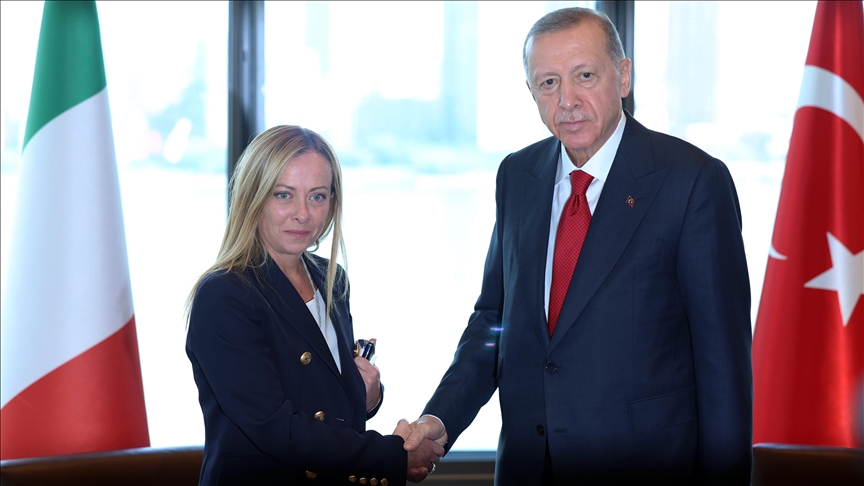
Europe must be ‘very alert’ heading into ‘high fire danger’ season: Expert
Iberian peninsula, eastern part of Mediterranean region are areas of particular concern this summer, says European Commission Joint Research Center’s Jesus San-Miguel- Wildfire season of 2024 could be even more complicated than past years ‘because we have a lot of biomass on the ground,’ researcher tells Anadolu- European region is well-prepared in terms of means but simultaneous fires will prove challenging, says San-Miguel
By Muhammed Enes Calli
ISTANBUL (AA) – 2023 was a year of intense wildfires around the world, with many regions such as Europe seeing record-breaking activity causing colossal damage, and experts are sounding the alarm for another “high fire danger” season this summer.
For Europe, wildfire seasons have been continuously difficult since 2021, and last year was “among the worst five seasons” for the continent, according to Jesus San-Miguel, a senior researcher at the European Commission’s Joint Research Center (JRC).
While European nations and the EU have ramped up mitigation efforts, the continent must remain “very alert” over the coming months, he told Anadolu.
According to the JRC’s Advance Report on Forest Fires in Europe, Middle East and North Africa 2023, an area approximately twice the size of Luxembourg, totaling more than 500,000 hectares, was burnt in the EU last year.
San-Miguel, who is also responsible for operation and development of the European Forest Fire Information System (EFFIS), said the Mediterranean region specifically is likely to witness a particularly “complicated” wildfire season this year.
He said temperatures will remain above average for the entire duration of the summer and rainfall is expected to be lower than usual.
“We are expecting high fire danger conditions,” he said.
So far this year the Mediterranean has seen a lot of rain, with significant precipitation still occurring and this is contributing to the generation of more biomass, he explained.
“The situation may be even more complicated in the summer when all this biomass becomes dry and then becomes fuel for fires,” he said.
“We have to be really very alert for this summer because we have a lot of biomass on the ground.”
- Areas at higher risk
Some areas of particular concern this summer are the Iberian peninsula and the eastern part of the Mediterranean region, said San-Miguel, including countries such as Greece, Türkiye, Lebanon and some others in Central Europe.
Last year, Spain had at least 1,397 fires that burned nearly 102,000 hectares, while at least 938 fires in Portugal scorched over 43,000 hectares, according the JRC’s report for 2023.
In Greece, almost 175 fires devoured almost 176,000 hectares, with one forest blaze in Dadia National Park determined to be the largest wildfire recorded in the EU since 2000, when the EFFIS started keeping records.
On the reasons for the increased danger, San-Miguel said it is clear now that “the conditions we are suffering in in Europe are driven by climate change.”
“The temperatures and the intensity of the fires now are above anything we have seen before. Vegetation is very dry. Temperatures are very high. There are continuous droughts, and that leads to fires that cannot be extinguished. This is why the burnt area is increasing,” he said.
“The ignitions are as before, still mainly caused by people … If the fire danger is very high, it will propagate very fast with high intensity.”
With human actions among the leading cause of wildfire outbreaks, San-Miguel stressed the need for education and awareness programs.
“If they are aware that there is a wildfire risk in an area, then they will not ignite fires there. We should also work with rural populations because many of the blazes occur because of the use of fire to eliminate vegetation and residuals from agriculture,” he explained.
“People need to be aware of the risk of fire and then be educated on what to do not to create fires.”
- Europe has means but limitations persist
Despite the growing danger, San-Miguel believes the wider European region is “well-prepared” to combat the problem, particularly “in terms of means.”
Along with the steps taken by countries individually, preparations are also made at the EU level, with a series of mechanisms to give them additional resources, he said.
According to a recent Euronews report, the EU has assembled a team of 556 firefighters from 12 countries to be strategically positioned across key European countries.
Additionally, the bloc is introducing a rescue fleet of firefighting aircraft, including 28 planes and four helicopters stationed in 10 countries.
A total of €600 million ($644 million) in extra EU funds will be allocated to purchase 12 additional firefighting planes in the future, to be distributed among six countries along with several helicopters.
For individual countries, the report said France has bolstered its Departmental Fire and Rescue Service with some 3,600 firefighters and 600 vehicles, while it also has 12 firefighting planes capable of carrying more than 6,000 liters of water each.
In Portugal, nearly 12,100 operational units and 70 aircraft will be available for combatting fires, while Spain recruited hundreds of new firefighters and has at least 22 aircraft, four amphibious craft, and over 800 land vehicles.
However, San-Miguel emphasized that there will always be limitations and challenges despite any number of resources.
“If there are so many simultaneous fires, it’s very difficult to fight all of them,” he added.
Kaynak:![]()
This news has been read 316 times in total









Türkçe karakter kullanılmayan ve büyük harflerle yazılmış yorumlar onaylanmamaktadır.